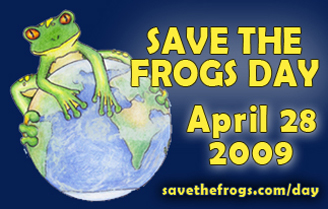|
|
Founder and director of SAVE THE FROGS!, Dr. Kerry Kriger is responsible for the first annual Save The Frogs Day on Tuesday, April 28th with events planned worldwide from the United States to Nepal, and Australia to China.
“I’m continually amazed at the positive response it’s gotten. I thought of Save The Frogs Day one night last December when I was the only full-time SAVE THE FROGS! employee and I only had a couple part-time volunteers,” Kriger explains.
Just this week in Virginia, Governor Tim Kaine has officially recognized the date for his state. “To the best of my knowledge that makes him the highest ranking politician in the world to formally acknowledge the amphibian extinction crisis,” Kriger comments, who will be speaking in Charlottesville, Virginia on April 28th.
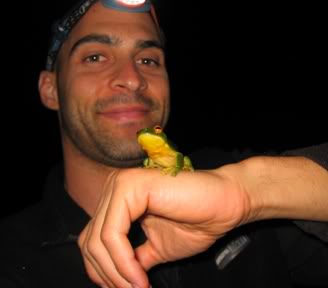 Kerry Kriger with the Red-eyed tree frog Litoria chloris from Eastern Autralia. Photo Courtesy of SAVE THE FROGS!. |
In Nepal a scientist plans to use his radio show to spread the message about imperiled frogs. In Madagascar a mining employee has scheduled a discussion with the mine’s top executives about frogs. In China, a researcher will speak on behalf of frogs to 3,000 students via television. In addition free lectures are occurring in Lisbon, Johannesburg, Torino, Indianapolis, and Brisbane to name a few places.
Kriger, a research biologist who has studied the amphibian plague chytridiomycosis, started SAVE THE FROGS! because “there was little to suggest that our society was on the path to saving threatened frogs or other amphibian species. Few people knew frogs were disappearing and there was no movement to avert an impending environmental disaster,” he told Mongabay.com.
Solely devoted to saving amphibians, SAVE THE FROGS! is focused on a multi-pronged approach, including community outreach efforts (like ‘Save the Frog Day’), education, legal defense, acquiring land vital for amphibians, lobbying for environmental protections, and funding scientific research.
Amphibians are one of the most threatened groups of animals in the world. “Habitat destruction, pesticides, pollution, climate change, invasive species, over-harvesting for the food and pet trades, and infectious diseases that are spread by human activity are all contributing to the problem,” Kriger says. In addition, the fungal disease chytridiomycosis has decimated wild amphibian populations globally, spread from one location to another by human traffic and trade. Currently, one third of all amphibians are threatened with extinction, while 200 species are likely already gone.
 Logo for SAVE THE FROGS!. |
Kriger emphasizes that everyone can have a role in saving frogs—and his website’s expansive page on the topic is testament to this. Some activities include foregoing the use of pesticides, not buying bottled water, driving slower to avoid running over frogs, and eating less meat, which has led to widespread deforestation, destroying amphibian habitats worldwide. In addition Kriger says: “vote for the environment. Decades of environmental progress can be destroyed by a bad politician in a single term.”
Despite the daunting nature of the amphibian crisis and the fact that society is largely unaware of the issue, Kriger believes that “if everyone steps up, gets involved and does their part, then we have a high chance of saving frogs from extinction.” This is what Save the Frogs Day is ultimately about.
“Frogs have successfully adapted to numerous environmental disturbances over the past 250 million years of their existence. Yet in the last half-century we have driven thousands of species to the verge of extinction,” Kriger says. “I think this says a lot about the extent and the severity of the environmental damage that humans have caused in recent times, and of the urgency with which we need to act in order to save the frogs, and save ourselves.”
INTERVIEW
Mongabay: Tell us about SAVE THE FROGS!. What is the organization’s mission? What led you to start the organization?
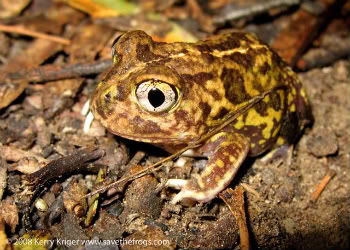 The painted burrowing frog Neobatrachus pictus from Autralia. Photo by Kerry Kriger. |
Kerry Kriger: Our mission is to prevent an imminent mass extinction of amphibians that is already well underway. One-third of the world’s 6,485 species of frogs, toads, newts, salamanders and caecilians are on the verge of extinction, and 200 species have completely disappeared in recent years. We plan to prevent further extinctions through a combination of methods: environmental education, legal defense, land acquisitions, lobbying for necessary environmental protections that currently do not exist and by conducting and funding scientific research.
I started SAVE THE FROGS! because there was little to suggest that our society was on the path to saving threatened frogs or other amphibian species. Few people knew frogs were disappearing and there was no movement to avert an impending environmental disaster. Neither universities nor government agencies had sufficient funds or the capacity to adequately protect remaining amphibian populations, and there was no other nonprofit dedicated exclusively to amphibian conservation.
Mongabay: April 28th 2009 is the first annual Save The Frogs Day—what sort of events are going on worldwide?
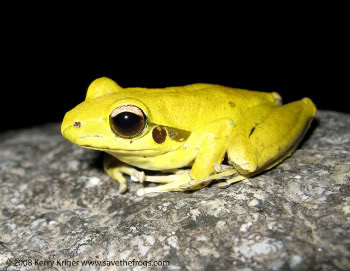 The northern stony creek frog Litoria jungguy from Autralia. Photo by Kerry Kriger. |
Kerry Kriger: There are currently about forty scientists from sixteen countries who have agreed to give public lectures on the amphibian extinction crisis on Save The Frogs Day. There are also museums and zoos helping to raise awareness of frog extinctions; schools worldwide taking part in our first annual frog poetry and frog art contests; and even businesses devoting a portion of their day’s sales to SAVE THE FROGS! conservation efforts.
Mongabay: What successes has SAVE THE FROGS! had so far?
Kerry Kriger: I think the coolest thing that’s happened so far is Save The Frogs Day. I’m continually amazed at the positive response it’s gotten. I thought of Save The Frogs Day one night last December when I was the only full-time SAVE THE FROGS! employee and I only had a couple part-time volunteers. I figured I’d see if I could get the day legally recognized, so I sent a letter to Governor Tim Kaine of Virginia. After a couple months, I hadn’t heard anything back, so I sent another letter. I still didn’t hear anything so I called his office. Last week he sent me a proclamation officially recognizing April 28th, 2009 as Save The Frogs Day in the state of Virginia. To the best of my knowledge that makes him the highest ranking politician in the world to formally acknowledge the amphibian extinction crisis. Next year we’ll have a massive push to get every state’s governor recognizing Save The Frogs Day.
The internet has been a great tool for getting Save The Frogs Day activities going on in other countries. Yesterday I got an email from an employee of a large mining company in Madagascar who had arranged to talk to the company’s executives about the importance of conserving frog populations. The day before that a Nepali scientist wrote me to say that he will be talking about frogs live on Nepali radio on Save The Frogs Day. Probably my favorite event taking place is in China, where a Chinese researcher’s Save The Frogs Day talk to a high school class will be televised to all 3,000 students in the school.
I guess the most important thing I’ve taken away from it is that with dedication and hard work one person can set things in motion and have a huge effect. Imagine how much we could accomplish if everyone worked towards our common goal of a better planet on which to live.
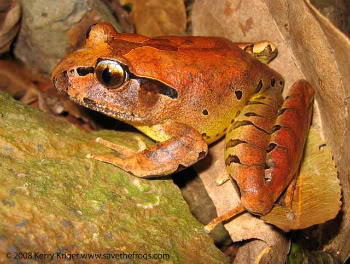 The endangered Fleay’s barred frog Mixophyes fleayi from rainforests in Autralia. Photo by Kerry Kriger. |
Mongabay: Why are frogs so threatened worldwide?
Kerry Kriger: Habitat destruction, pesticides, pollution, climate change, invasive species, over-harvesting for the food and pet trades, and infectious diseases that are spread by human activity are all contributing to the problem. Frogs have permeable skin that can absorb pollutants, many of which inevitably drain into the waterways frogs depend on. Also, frogs’ amphibious lifestyles make them highly dependent on both the land and the water; if problems arise in either the terrestrial or aquatic realms, frogs are likely to be affected. Another problem is that unlike birds or humans, frogs cannot travel far. So when a frog’s habitat is threatened they cannot easily fly away or pack up and move. They either have to adapt or they will disappear. Frogs have successfully adapted to numerous environmental disturbances over the past 250 million years of their existence, yet in the last half-century we have driven thousands of species to the verge of extinction. I think this says a lot about the extent and the severity of the environmental damage that humans have caused in recent times, and of the urgency with which we need to act in order to save the frogs, and save ourselves.
Mongabay: Why do you think the mass extinction of frogs is still so little known by the public?
Kerry Kriger: Most people have little interaction with frogs. Frogs tend to be active at night when humans are asleep, and they are most active in the rain, when humans go inside. So humans have less of a connection with frogs than they do with more visible animals like birds. Perhaps more importantly, the environment takes low priority in our society. I can’t recall the topic of deforestation or pesticides or wildlife extinction being brought up in the recent presidential debates. This lack of concern for the planet trickles down to the school system, where there is too little focus on environmental education.
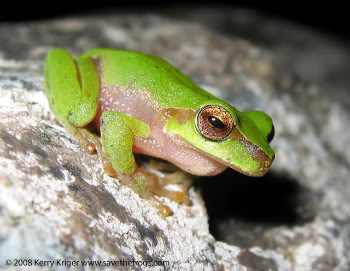 The cascade treefrog Litoria pearsoniana is considered Vulnerable by Queensland, Autralia. Photo by Kerry Kriger. |
Mongabay: You have done a lot of research on chytridiomycosis—what have you uncovered so far?
Kerry Kriger: Chytridiomycosis is a lethal skin disease caused by a chytrid fungus that has been transported around the globe by humans in recent decades. There are likely hundreds of thousands of sick frogs that get shipped around the world each year for use as pets or food. When a sick frog or the water it was held in escapes or is released into the wild, the chytrid fungus can become established in native frog populations, where it is likely spread by streams and via frog to frog contact, often with devastating consequences, such as the entire extinction of species within a matter of months.
My research was concerned with determining which types of frogs are most prone to chytrid infections, and when disease outbreaks are most likely to occur. I sampled about 3,000 frogs up and down the east coast of Australia by running a cotton swab over their skin to pick up any fungal DNA that would be present if the frog were infected. I found the fungus was widespread throughout eastern Australia, though it was most prevalent in the cooler southern regions. The only places I did not find the fungus were hot, dry locations, likely because the fungus needs moisture and cool temperatures to survive. The fungus was in the mountains and the lowlands, but infections were generally restricted to stream-breeding species and mostly in the cooler months of the year. This information assists scientists worldwide by allowing them to predict which species and populations are at highest risk of chytridiomycosis-related declines, and to focus monitoring and conservation efforts accordingly.
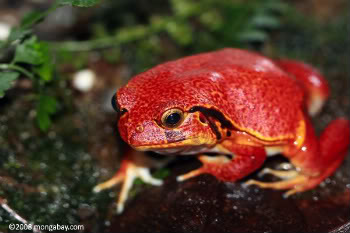 The tomato frog from Madagascar. Photo by Rhett A. Butler. |
Mongabay: What can the average person do to help save frogs?
Kerry Kriger: I actually think the average person can do a lot to save frogs. Mostly it comes down to the basic question of “what effect do my actions have on the environment?”. Homeowners can start by not using pesticides. They cause limb deformities and hermaphroditism in frogs. Not eating frog legs would go a long way towards reducing the spread of infectious diseases. In a recent study, nearly two-thirds of the bullfrogs that were being imported into the USA for use as food were infected with the chytrid fungus, the causative agent of 100 amphibian species extinction worldwide. Never purchase wild-caught amphibians as pets. Most of the brightly colored species that people like as pets come from tropical developing nations with few regulations on over-harvesting. Don’t stock your pond or stream with non-native fish as some species, such as mosquitofish or trout, are voracious predators of frogs. Don’t purchase bottled water unless you have to. The production of plastic is terrible on the environment and contributes to global warming. Ten years ago, few Americans drank bottled water on a regular basis, but now it is almost the default.
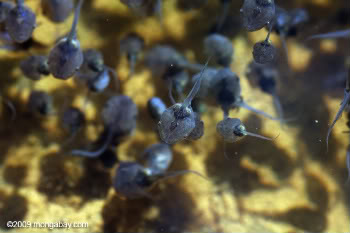 Tadpoles in Laos. Photo by Rhett A. Butler. |
There are 600 million cars on the road. If every car hit only one frog every ten years it would be 600 million dead frogs every decade, so people should slow down driving on warm, wet nights. Reducing one’s meat consumption is a simple way to help save frogs. Deforestation is rampant in many parts of the world, and is often done to create land to graze cattle, which trample stream habitats, pollute the water with manure, and contribute to global warming. Nearly 30% of America’s methane emissions come from hooved animals like cows, pigs and sheep, and methane is a harmful greenhouse gas. There are plenty more ways the average person can help save frogs, many of which our listed on the savethefrogs.com ‘How To Help’ page, but for now I’ll end with one last way: vote for the environment. Decades of environmental progress can be destroyed by a bad politician in a single term.
Mongabay: What advice do you have for students interested in pursuing a career in conservation?
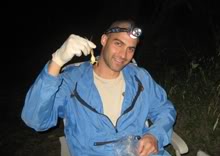 Kriger holding his last frog from his PhD study . Photo courtesy of SAVE THE FROGS!. |
Kerry Kriger: Focus on math, science and writing when in high school, and then major in environmental science or ecology if you like working outdoors or environmental law or policy otherwise. Volunteer and get some field experience. Surround yourself with people who are passionate about what they do. Go for a hike if you ever forget why you chose environmental conservation as a career, and remember that if you work hard at something, success is inevitable.
Mongabay: Working with frogs everyday, how much hope do you have for their future?
Kerry Kriger: I spent most of my life being fairly pessimistic about the future of the planet, especially with regards to the environment. The threats to frogs are enormous and our society is not doing nearly enough at this moment to prevent the imminent mass extinction of a wide array of wildlife, including frogs. However, there has been a definite surge in the environmental movement over the past few years. I’m definitely doing everything I can to make this movement grow exponentially in the near future. If everyone steps up, gets involved and does their part, then we have a high chance of saving frogs from extinction. But we don’t have any time to waste.
For a list of events on Save the Frogs Day: http://www.savethefrogs.com/events/index.html
Information for teachers: http://www.savethefrogs.com/teachers/index.html
Information for students: http://www.savethefrogs.com/students/index.html
How to help frogs: http://www.savethefrogs.com/how-to-help/index.html
Related articles
After disease engulfs island, rare mountain chicken frogs airlifted to safety
(04/23/2009) In a rescue operation that sounds straight out of an action film, 50 mountain chicken frogs were airlifted from the Caribbean island Montserrat after the discovery of Chytridomycosis, a fungal disease that has wiped out amphibian populations worldwide. Already, hundreds of the critically-endangered mountain chicken frogs succumbed to the disease, which is thought to have made its way to the island in late 2008 or early 2009.
Amphibians could develop immunity against devastating fungal disease
(04/03/2009) The fungal disease chytridiomycosis has ravaged amphibian populations, including contributing to several extinctions. But new research may bring some hope for currently threatened amphibians.
Salamander populations collapse in Central America
(02/09/2009) Salamanders in Central America — like frogs, toads, and other amphibians at sites around the world — are rapidly and mysteriously declining, report researchers writing in the journal Proceedings of the National Academy of Sciences. Disturbingly, salamanders are disappearing from protected areas and otherwise pristine habitats.
One billion frogs harvested as food per year
(01/21/2009) The consumption of up to one billion frogs per year to satisfy human appetite for frog flesh is adding to the litany of pressures on global amphibian populations, write researchers in the upcoming issue of Conservation Biology.
Lack of information may slow conservation response to amphibian crisis
(12/01/2008) The Neotropics harbor between 30-50% of the world’s reptiles and amphibians, but dramatic declines in both groups have been observed over recent decades. While a number of factors have been cited, many of the causes of reptile and amphibian declines are still poorly understood. The situation is paralleled by a lack of information of the natural history, ecology, and behavior of many species.
Prioritizing amphibian species for captive breeding to save them from extinction
(11/13/2008) Frogs, toads, salamanders and other amphibians are disappearing at an alarming rate. Of approximately 6,000 amphibian species in the world, about one third are classified as threatened or endangered. A disease caused by a chytrid fungus has devastated frogs living in mid to high elevation streams worldwide. Amphibians also face habitat destruction as forests and wetlands are developed and polluted by agricultural chemicals. In Panama, highland frog populations west of the Canal have declined at an alarming rate.
Scientists can’t explain cause of amphibian extinction crisis
(11/13/2008) Scientists have yet to conclusively explain the underlying cause of global declines in amphibian populations, according to a study published in the journal Proceedings of the National Academy of Sciences. The research says that two leading theories for the demise of amphibians; both related to the emergence and spread of the deadly chytrid fungus; are not supported by scientific data.
Mass amphibian die-offs affect ecosystems
(10/19/2008) Large-scale die-offs of amphibians due to the outbreak of a killer fungal disease is impacting the forest ecosystem in which they live, reports a new study published in the journal Ecosystems.
Armageddon for amphibians? Frog-killing disease jumps Panama Canal
(10/12/2008) Chytridiomycosis — a fungal disease that is wiping out amphibians around the world — has jumped across the Panama Canal, report scientists writing in the journal EcoHealth. The news is a worrying development for Panama’s rich biodiversity of amphibians east of the canal.
52% of amphibians, 35% of birds at risk from climate change
(10/08/2008) 52 percent of the amphibians, 35 percent of birds and 71 percent of reef-building coral are “particularly susceptible” to climate change, warns an IUCN report.
